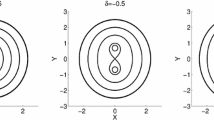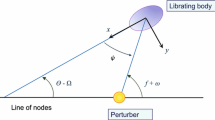Abstract
We discuss a model describing the effects of tidal dissipation on the satellite’s orbit in the two-body problem. Tidal bulges are described in terms of a dumbbell, coupled to the rotation by a dissipative interaction. The assumptions on this dissipative coupling turn out to be crucial in the evolution of the system.


Similar content being viewed by others
Notes
More precisely, a frictional torque
References
Efroimsky, M., Bodily Tides near Spin-Orbit Resonances, Celestial Mech. Dynam. Astronom., 2012, vol. 112, no. 3, pp. 283–330.
Makarov, V. V. and Efroimsky, M., No Pseudosynchronous Rotation for Terrestrial Planets and Moons, Astrophys. J., 2013, vol. 764, no. 1, 27 pp.
Efroimsky, M., Tidal Evolution of Asteroidal Binaries. Ruled by Viscosity. Ignorant of Rigidity, Astronom. J., 2015, vol. 150, no. 4, Art. 98, 12 pp.
Ferraz-Mello, S., Ragazzo, C. G., and dos Santos, L. R., Dissipative Forces in Celestial Mechanics, in \({30}^{\rm o}\) Colóquio Brasileiro de Matemática, Rio de Janeiro: IMPA, 2015, 139 pp.
Gevorgyan, Y., Boué, G., Ragazzo, C., Ruiz, L., and Correia, A. C. M., Andrade Rheology in Time-Domain. Application to Enceladus’ Dissipation of Energy due to Forced Libration, Icarus, 2020, vol. 343, 113610, 22 pp.
Celletti, A. and Sidorenko, V., Some Properties of the Dumbbell Satellite Attitude Dynamics, Celestial Mech. Dynam. Astronom., 2008, vol. 101, no. 1–2, pp. 105–126.
Sidorenko, V. V. and Celletti, A., A “Spring-Mass” Model of Tethered Satellite Systems: Properties of Planar Periodic Motions, Celestial Mech. Dynam. Astronom., 2010, vol. 107, no. 1–2, pp. 209–231.
Murray, C. D. and Dermott, S. F., Solar System Dynamics, Cambridge: Cambridge Univ. Press, 1999.
Ragazzo, C. and Ruiz, L. S., Viscoelastic Tides: Models for Use in Celestial Mechanics, Celestial Mech. Dynam. Astronom., 2017, vol. 128, no. 1, pp. 19–59.
ACKNOWLEDGMENTS
The authors want to thank the anonymous referees whose contributions have helped to improve the readability of the paper. We are indebted to Ugo Locatelli for many useful discussions. We have also benefited from several comments of Giuseppe Pucacco and Gabriella Pinzari.
Funding
This work has been supported by PRIN-CELMECH. BS acknowledges the support of the Italian MIUR Department of Excellence grant (CUP E83C18000100006). AT has been supported through the H2020 Project Stable and Chaotic Motions in the Planetary Problem (Grant 677793 StableChaoticPlanetM of the European Research Council).
Author information
Authors and Affiliations
Corresponding authors
Ethics declarations
The authors declare that they have no conflicts of interest.
Additional information
MSC2010
70F05, 70F15
APPENDIX A. COMPUTATION OF $$\varepsilon(t)$$
In this appendix we want to show the detailed computation of \(\varepsilon(t)\) starting from Eq. (2.17), which we rewrite in this form:
First of all, we compute \(\frac{\partial L}{\partial\varepsilon}\) from Eq. (2.4):
Recall that \(\mu\) represents the mass of the ocean’s bulges. These bulges can be imagined as an ellipsoid of radii \(R_{E}\), \(R_{E}\) and \(R_{E}+h\) deprived of a sphere of radius \(R_{E}\) concentric to it, \(h\) being the tidal height.
If we replace \(h\) with the Newton formula for tidal height:
Therefore,
Equation (A.1) thus becomes
A trivial solution of this equation is
Remark 1
The ratio \(\frac{\alpha}{\gamma_{c}}\) contains, as a whole, the information about the quantities appearing in the system. This suggests, for instance, that the friction coefficient \(\alpha\) has to decay very fast for increasing \(a\), the semimajor axis of the orbit, in order to balance the dependence of \(\gamma_{c}\) on \(a\) (see the comments immediately following (2.5)). This sounds reasonable, since the friction should depend on the total amount of liquid involved in the motion of the bulges, and this clearly depends on \(a\). However, we do not have a detailed model of the tidal currents inside the oceans (in the Earth – Moon case) or in the inner mantle (Io – Jupiter case). We think that one of the virtues of the simple model we presented in this work is the fact that it suggests the correct relations among the various elements of the orbits, while their quantitative evaluation has to be based on empirical observations.
APPENDIX B. CHARACTERISTIC TIMESCALES OF THE SYSTEM
In this appendix we want to compare the characteristic timescales of the system in order to show that the assumptions we made in our model are justified.
In particular, as we explained above, we are interested in the comparison between the timescale of elongation of the semimajor axis, which we call \(\tau_{a}\), and the timescale of circularization of the orbit, that is, \(\tau_{M}\) or \(\tau_{I}\) in Eqs. (2.29) and (3.12), respectively.
From Eq. (2.32) we see that \(\tau_{a}\simeq\tau_{\Omega}\), with \(\tau_{\Omega}\) the characteristic timescale of evolution of \(\Omega\). Moreover, we can rewrite Eq. (2.16) as
On the other hand,
Rights and permissions
About this article
Cite this article
Scoppola, B., Troiani, A. & Veglianti, M. Tides and Dumbbell Dynamics. Regul. Chaot. Dyn. 27, 369–380 (2022). https://doi.org/10.1134/S1560354722030078
Received:
Revised:
Accepted:
Published:
Issue Date:
DOI: https://doi.org/10.1134/S1560354722030078




